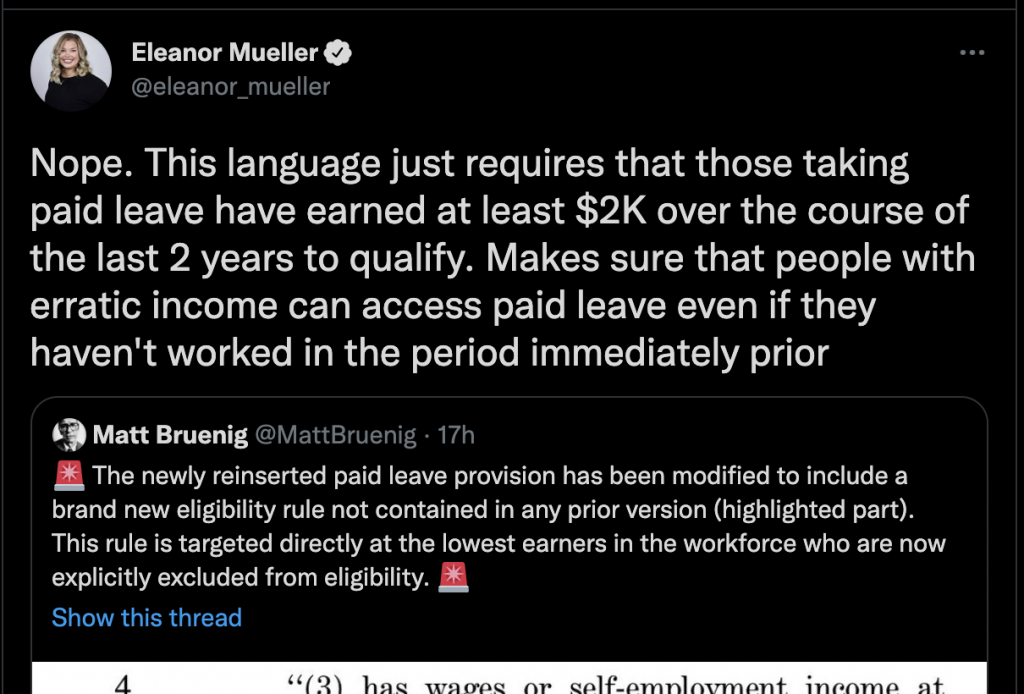House Democrats released a new version of their Build Back Better (BBB) reconciliation legislation late yesterday afternoon. The new bill brings back a modified version of the paid leave proposal that was cut out of the bill they released just a few days ago.
The biggest change in the new paid leave proposal, which is the only change that journalists seem to have picked up on, is that the benefit now runs for 4 weeks instead of 12 weeks. But there is a smaller, more insidious change as well: the new eligibility rules now explicitly exclude the lowest earners in the workforce.
What It Used to Say
Here is how eligibility for benefits was defined in the last version of this legislation:
(a) ENTITLEMENT.—Every individual who—
(1) has filed an application for a paid family and medical leave benefit in accordance with section 2204(a);
(2) has, or anticipates having, at least 4 caregiving hours in a week ending at any time during the period that begins 90 days before the date on which such application is filed or not later than 180 days after such date; and
(3) has wages or self-employment income at any time during the period—
(A) beginning with the most recent calendar quarter that ends at least 4 months prior to the beginning of the individual’s benefit period specified in subsection (b); and
(B) ending with the month before the month in which such benefit period begins,
shall be entitled to such a benefit for each month during such benefit period, except as otherwise provided in this section.
Paragraph 1 says you need to file an application. Paragraph 2 says you need to have or anticipate having caregiving days.
Paragraph 3 is the work history requirement. Instead of making paid leave universal in the way many of our peer countries do, paragraph 3 restricts eligibility to people who had any amount of earnings in the last 7 months, 8 months, or 9 months, depending on when precisely they take their leave.
This work history test was designed to exclude around 1 in 3 new mothers, including those who are still in education, disabled, or who have had a recent spell of unemployment.
What It Says Now
Here is the new rule:
(3) has wages or self-employment income at any time during the period—
(A) beginning with the most recent calendar quarter that ends at least 4 months prior to the beginning of the individual’s benefit period specified in subsection (b); and
(B) ending with the month before the month in which such benefit period begins; and
(4) has at least the specified amount of wages and self-employment income during the most recent 8-calendar quarter period that ends at least 4 months prior to the beginning of the individual’s benefit period specified in subsection (b),
shall be entitled to such a benefit for each month during such benefit period, except as otherwise provided in this section. For purposes of paragraph (4), the specified amount for individuals whose benefit period begins in calendar year 2024 shall be $2,000.
In the new version, we still have paragraph 3, which requires that you record some kind of earnings in the period immediately preceding your leave. But now we also have paragraph 4, which requires that you have earned at least $2,000 in the prior two years.
So when reinserting paid leave back into the bill, the Democrats modified the eligibility rule to ensure that the lowest earners in the workforce cannot claim benefits from the program. These people were already not going to get very much under the prior version. But now they aren’t going to get anything.
What Liars Are Saying
When I first spotted this yesterday, I quickly tweeted it out, explaining the issue. Around an hour later, Politico’s Eleanor Mueller (the same person who wrote the piece about my child care analysis a couple of weeks ago) responded this way:

This tweet was then immediately retweeted by Elana Schor (Politico), Kate Davidson (Politico), Ben Lefebvre (Politico), Alex Thompson (Politico) and then by Diana Hussein (UNITE HERE) and Susan Valentine (UNITE HERE). Only four other people retweeted it.
This tweet is inarguably wrong. It is false. It is not correct. It is inaccurate. It is untrue. And this is not a question where people might be able to reach different conclusions, such as “what is the best way to win an election” or “what will be the second and third order effects of this on the labor market.” This is a simple reading comprehension question: what does the text of the bill say?
Paragraph 4 does indeed require “that those taking paid leave have earned at least $2K over the course of the last 2 years to qualify.” But it absolutely does not make “sure that people with erratic income can access paid leave even if they haven’t worked in the period immediately prior.” The requirement that they have “worked in the period immediately prior” is contained in paragraph 3, which as you can see clear as day above is still in the bill.
Mueller seems to think that paragraph 4 replaced paragraph 3. But this is not the case. Paragraph 4 is a new restriction that is coming in on top of paragraph 3. It does not help people with erratic incomes. It does nothing but make some people who were eligible under the prior version of the bill ineligible under the new version of the bill. And the people it knocks out of eligibility are the lowest earners in the workforce.
To be clear here, based on what I know of how these things work, I don’t think Mueller is lying here. I think someone is lying to her. The fact that she, and her Politico colleagues, decided to proliferate that lie is condemnable as well (I won’t do the whole liberal media engages in misinformation campaigns bit here, though I am tempted). But the bigger issue is that advocates are lying about what they are doing to the press. They are tightening the rope on the neck of the poor but don’t want anyone to know it.

